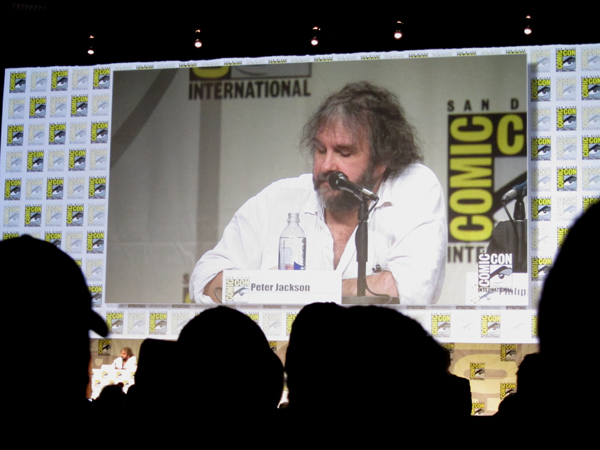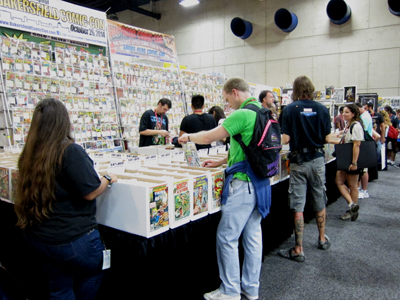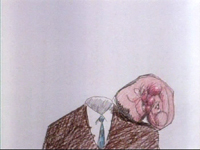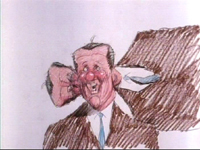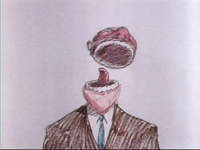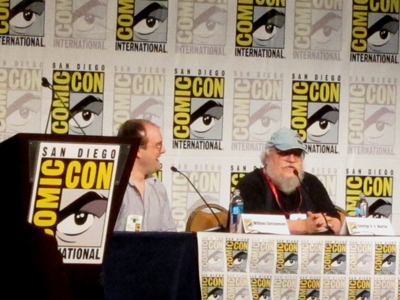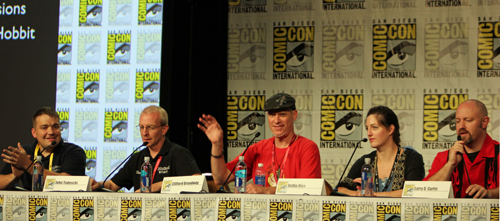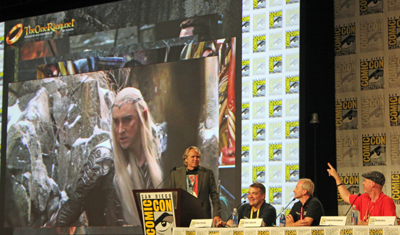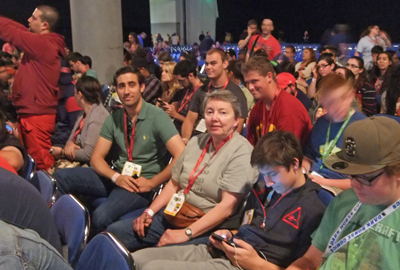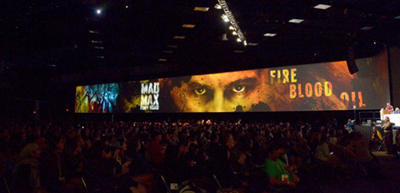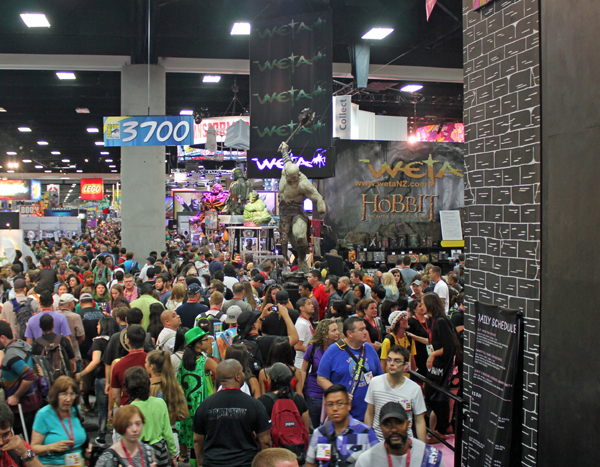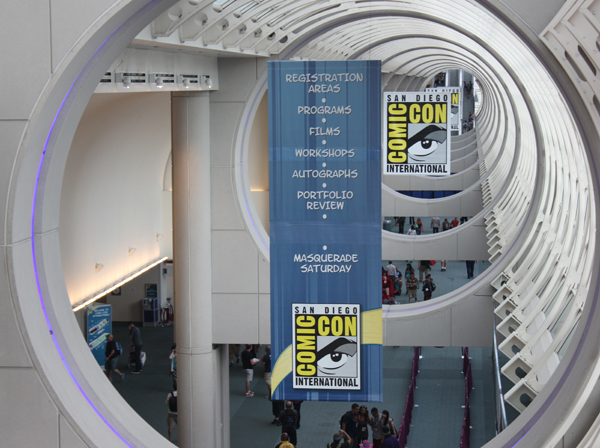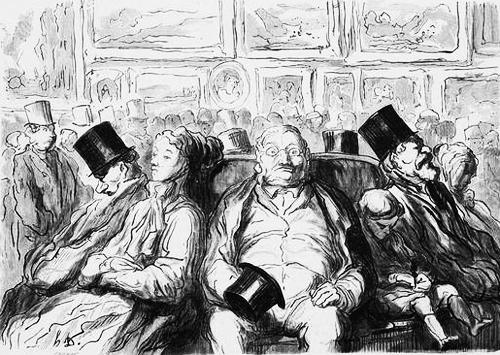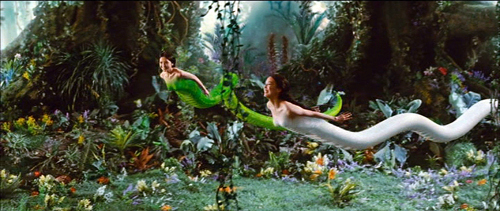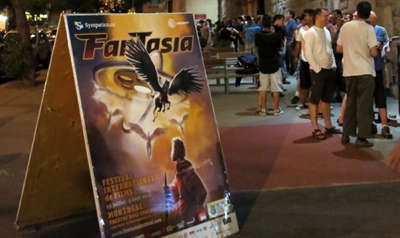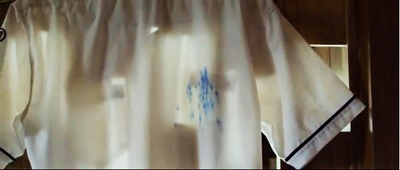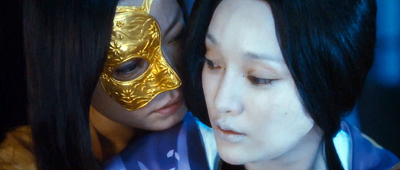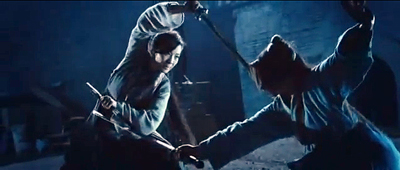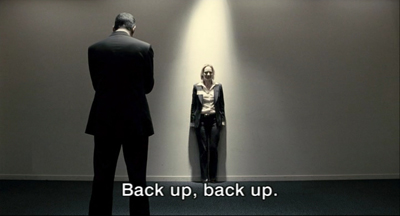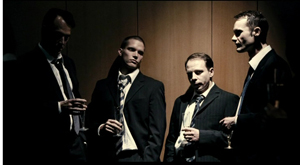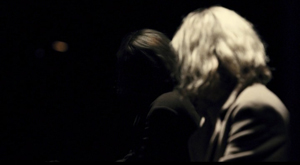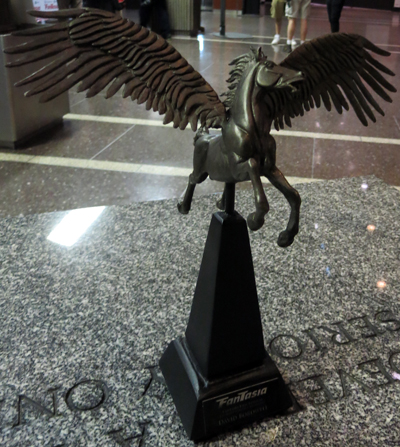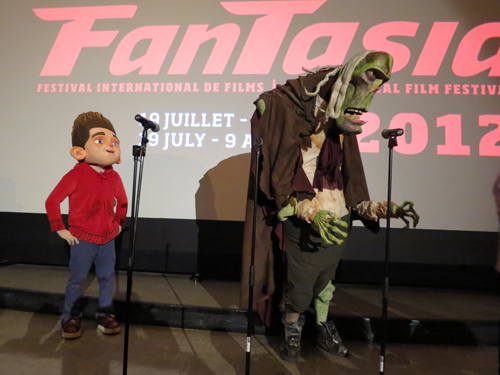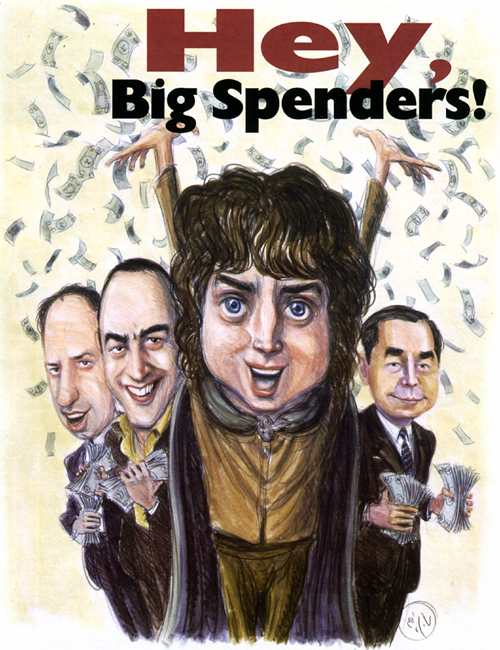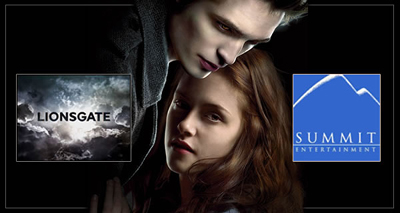Archive for the 'Festivals' Category
Comic-Con: The end of an era, and other highlights
Kristin here:
Long-time readers of this blog may recall that in 2008 I went to Comic-Con for the first time. I can’t recall exactly what led me to take the plunge. It may have been that by that time it was evident that the con had grown into a major opportunity for Hollywood studios to publicize their upcoming blockbusters to their core audience and I wanted to witness the process in person. Until this year, I hadn’t returned to Comic-Con. I was motivated in part by the fact that this was the last big promotional event for a film in the Lord of the Rings/Hobbit franchise. I had briefly discussed Comic-Con in relation to LOTR in The Frodo Franchise, but I had not witnessed any of the appearances of cast and crew promoting the first trilogy. This was my final chance, the end of an era.
I blogged about my first visit four times. I wrote about the LOTR/Hobbit presence on the Frodo Franchise blog. On this blog I gave an overview of the Comic-Con experience, analyzed why Hollywood poured so many resources into an event nominally about comic books, and posted a conversation between Henry Jenkins and me. Henry, who had helped found the area of fan studies back in the 1990s with such widely cited publications as Textual Poachers, was also a Comic-Con newbie that year, and we shared our reactions. (This year Henry was on a panel, “Creativity Is Magic: Fandom, Transmedia, and Transformative Works,” one of a number of panels on fan culture. I missed it because I was in line for Hall H. More on that below.)
A friend of mine who has a press pass assured me that they were not as hard to obtain as I had feared, so, based on my collaboration on this blog and my position on the staff of TheOneRing.net, I applied. To my delight, I was granted one, so I set out to cover Comic-Con more officially.
Going to Comic-Con alone isn’t nearly as fun, and I was lucky enough this year to meet up there with my friends, Professors Jonathan Kuntz and Maria Elena le las Carreras and their irrepressible daughter Rebecca, who are always terrific company.
Preview night
On the Wednesday evening before Comic-Con begins, there is a preview. This means that people with various special passes can get into the big exhibition hall where most of the booths are set up. These range from dealers in rare comic books to the biggest entertainment companies, like Warner Bros. and Lego. Many of them offer unique items only for sale or give-away at Comic-Con.
Many attendees have realized this, and they buy tickets that include the preview evening. The floor was much more crowded than when I attended the preview night in 2008. There were lots of lines with people trying to get those unique collectibles.
Others were there to look at comics. Yes, there are still plenty of comics at Comic-Con. There are dealers offering rarities, as in the image above. There are comics publishers with their latest offerings.
A particular favorite of ours is Fantagraphics, which specializes in reprinting comics. They’ve launched a set of hard-cover volumes of Walt Kelly’s syndicated Pogo strips. They also, I discovered, are doing a series of Don Rosa comics, also in hardback. In fact, when I was strolling around the booth, I realized that Rosa himself was signing autographs until 8 pm. It was then 7:59, so I grabbed volume 1 and was the last person to get my copy signed. By the way, it includes “Cash Flow,” one of the Uncle Scrooge stories I mentioned in our first blog entry on Inception. Volume 1 hasn’t actually been published, but it’s available for pre-order on Amazon.
The big moment of my evening, entirely by chance.
My first press conference
Once you’re granted a press pass, your name is put on a list made available to the exhibitors and publicists planning events. Companies big and small send you announcements about signings, press 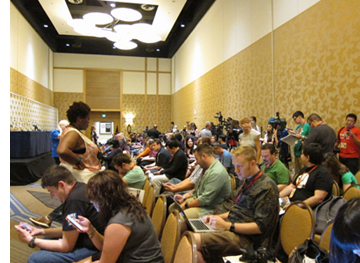 conferences, swag available at booths, parties in downtown venues, and so on. Many of these events promote video games, graphic novels, and television, but one sounded intriguing to my film interests: a press conference for Penguins of Madagascar, an entry in Dreamworks’ animated Madagascar franchise. The odd thing was that the event was scheduled in the morning at 11:15, fifteen minutes before the DreamWorks panel in Hall H. If we came to the conference, we couldn’t get into Hall H–unless the PR people reserved seats there for us. The big attraction was that some of the voice talent, including Benedict Cumberbatch and John Malkovich, as well as the two directors would be there.
conferences, swag available at booths, parties in downtown venues, and so on. Many of these events promote video games, graphic novels, and television, but one sounded intriguing to my film interests: a press conference for Penguins of Madagascar, an entry in Dreamworks’ animated Madagascar franchise. The odd thing was that the event was scheduled in the morning at 11:15, fifteen minutes before the DreamWorks panel in Hall H. If we came to the conference, we couldn’t get into Hall H–unless the PR people reserved seats there for us. The big attraction was that some of the voice talent, including Benedict Cumberbatch and John Malkovich, as well as the two directors would be there.
I showed up and got a front-row seat off to the side. The room filled up (right).
The event itself started somewhat late, and two gentlemen who were not Benedict Cumberbatch or John Malkovich appeared and answered some questions. (I would give their names, but the usual signs put on the table in front of guests were not in evidence.) We were approaching 11:25. John Malkovich and another gentleman appeared. Another couple of questions were asked, and someone announced that Benedict Cumberbatch’s plane had gotten in late the night before and besides we had to leave to make room for the next event scheduled in the room. We were not escorted to reserved seats in Hall H, where I hear that Benedict Cumberbatch did appear.
I can only trust that this is not how most press conferences turn out. Perhaps I will be invited to another one and find out.
Bill Plympton in person
Given that I had no option to go to the Hall H DreamWorks Animation presentation, I sought out an alternative among the several items offered during the noon slot. I had had my eye on a panel which had as its guests the well-known animator Bill Plympton, as well as Jim Lujan, the co-director of the feature-length Revengeance, in progress. David and have long been fond of Plympton’s work, especially his laugh-out-loud classic, Your Face (1987), which was nominated for an Oscar. It’s just a series of distortions of a man’s face as he sings an utterly wimpy love ditty (above).
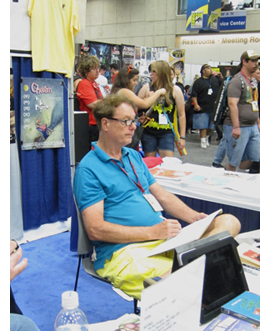 Plympton continues to be remarkably prolific. He has worked on fourteen episodes of The Simpsons, including doing twelve couch gags. Now he has a feature, Cheatin’, which will be shown for a week starting on August 15 at the downtown independent in Los Angeles. (Earlier this year it played at Slamdance, but I can find no theatrical release date.) You can see a short appeal animated by Plympton for the film’s Kickstarter appeal; its quite informative about the animation techniques used. The campaign itself is over, having raised $100,916, exceeding the goal of $75,000.
Plympton continues to be remarkably prolific. He has worked on fourteen episodes of The Simpsons, including doing twelve couch gags. Now he has a feature, Cheatin’, which will be shown for a week starting on August 15 at the downtown independent in Los Angeles. (Earlier this year it played at Slamdance, but I can find no theatrical release date.) You can see a short appeal animated by Plympton for the film’s Kickstarter appeal; its quite informative about the animation techniques used. The campaign itself is over, having raised $100,916, exceeding the goal of $75,000.
Apart from clips from Revengeance, Plympton also showed a brand new short, Footprints, a charming tale of a man’s search for a mysterious house invader. It will be shown on August 14 as part of the Hollyshorts Film Festival, which will honor Plympton with the Indie Animation Icon Award. The film was entirely hand-drawn in black and white and then colored digitally.
During the panel there was a contest for a T-shirt. The question was: What is Bill Plympton’s middle name? Despite a plethora of cell phones, laptops, and tablets in the audience, no one could come up with the right answer. A second question was put forth: what was Plympton’s first theatrically released film? “The Tune,” came a cry from the audience. It was Sam Viviano, art director of Mad Magazine; he walked off with the shirt. Plympton then sheepishly confessed that his middle name is Merton.
Plympton’s films have been hard to find online, but this fall they will become available on Source HD: “It’s the entire catalog, everything I’ve ever done.” That includes about 60 shorts. As a result of this online exposure, he says, “I expect that when I come back to San Diego next year they’re going to have to give me one of those huge 2000-seat rooms.” I hope so, and I hope it will be filled–but not so jammed that I could not get a seat.
Plympton offered all attending his panel a free autographed drawing. I went to collect mine at his booth in the exhibition hall and found him drawing (right), as he must constantly be doing. Note the Cheatin’ poster behind him at the left and the usual bustle of Comic-Con in the background. He paused to dash me off a delightful image of his famous Dog character. (An animator who doesn’t use cels has to be really fast at drawing.)
Plympton DVDs are not all that easy to find, though you can get them and other merchandise at his website’s shop. If you don’t know his work, it’s time to start catching up.
A new experience: The Indigo Ballroom
Seeking to accommodate more fans without violating fire regulations, Comic-Con has expanded into nearby buildings. One of the facilities utilized this year was the Hilton San Diego Bayfront, just across from the Convention Center on the Hall H end. That’s where the DreamWorks press conference sort of took place. Its biggest room was the Indigo Ballroom. I’m not sure it had 2000 seats, but I wouldn’t be surprised.
My colleagues at TheOneRing.net have been presenting panels on the Hobbit series for several years now. In fact, my visit to Comic-Con in 2008 was as a participant on one of those panels, speculating much before the fact on the shape that the Hobbit project would take. At that point the cast hadn’t even been chosen. I suggested that Wisconsin’s own Mark Ruffalo would make an excellent Thorin. I still think he would have, but Richard Armitage has gained a large fan following in that role. I’m not sure that at that early stage Martin Freeman was everyone’s favorite candidate for Bilbo, but he soon became so–including mine. The man is a born hobbit.
That 2008 panel took place in a relatively small room in the Convention Center. In more recent years, the TORn panel has been joined by such luminaries from the filmmaking team as Richard Taylor. It has gained such a following that this year it was booked into the Indigo Ballroom.
Then we learned that George R. R. Martin was booked into the same room in the time-slot directly before TORn. (I’m sure you all know who he is, but for the few who don’t, I’ll just say, he’s the author of the “A Song of Fire and Ice” series, of which Game of Thrones is the first book.) We were all convinced that Martin’s session would be jammed and furthermore that an overlap in fandoms would mean that the audience there for Martin would stay for the TORn panel, excluding those who showed up just before the TORn session. There was much discussion as to how TORn staff not on the panel (like me) could get in and be sure of a seat. How many seats could be reserved? We didn’t know.
I determined to support my colleagues and attend the TORn panel. The question was, how many sessions would I have to sit through to make sure I could get a seat? (Rooms are never cleared between sessions at Comic-Con, since doing so would take too much time and would mean that people in one room for a session would not be able to get in line for the next session in that room. Hence the strategy of sitting through multiple panels in the same room to guarantee a seat at the one you really want to see.)
I arrived early in the afternoon in the middle of a session about some show on Comedy Central. This finally ended and the George R. R. Martin panel began. To my surprise, it was only about two-thirds full. I learned later that Martin often attends Comic-Con. Moreover, this time he wasn’t talking specifically about Game of Thrones. The session was billed as “George R. R. Martin Discusses In the House of the Worm.” The title in question is a new comic-book series that Martin is involved with. (Above, William Christensen, publisher at Avatar Press, interviews Martin.)
I had expected to sit through Martin’s session merely waiting for the TORn one to begin. I had read Game of Thrones, widely assumed to be heavily influenced by The Lord of the Rings. Game of Thrones was entertaining, but by the end I found it repetitious. I figured that the series could only become more so, so I quit there. I haven’t seen the TV episodes. Yet Martin turned out to be quite entertaining. He is a long-time fan, and his reminiscences about fandoms during the 1960s and onward were fascinating. He’s a lively, knowledgeable, and entertaining speaker with a wide experience in both reading and creating fantasy works in those days. His presentation made me wish that I liked that first book better.
The next session was “An Unofficial Look at the Final Middle-earth Film: The Hobbit: The Battle of Five Armies.” (Actually in the program the title said “Final Middle-Earth Film,” but I’m sure my colleagues did not make that capitalization error when they proposed the panel.)
The panel consisted of, from the left, Chris “Calisuri” Pirotta, a TORn co-founder; John Tedeschi, long-time staffer; Cliff “Quickbeam” Broadway, frequent contributor to the site; Kellie Rice, staffer and half of the “Happy Hobbits” fan duo; and Larry D. Curtis, another long-time staffer and frequent contributor. Chris and Cliff were among several TORn interviewees when I was researching The Frodo Franchise.
TORn has made annual appearances at Comic-Con, usually speculating in expert fashion on what might be included–or not–in the next film. Staffers comb the previous films, trailers, Peter Jackson’s production diaries, publicity photos, and cast and staff interviews, seeking for clues. While presenting their findings, they point out things in the earlier parts that people might not have noticed or may have forgotten.
The first line in the Powerpoint image above refers to widespread fan annoyance that Bilbo seems to have been pushed to the periphery of his own story in The Desolation of Smaug. This is a topic of frequent comment on the website. The TORn panel was held on Thursday, two days before any of us had a chance to see the first teaser-trailer’s premiere on Saturday in Hall H. (More on that below.) Although there are shots of Bilbo in that trailer, they mainly show him staring offscreen and reacting. I was left hoping that this is not an indication of more sidelining of our protagonist. In Tolkien’s book Bilbo decides to sit out the Battle of Five Armies and gets knocked unconscious early in the fighting; given that he’s our point-of-view figure, the battle is mainly told through other characters describing it afterward. No one expects Peter Jackson to stay true to that action and sacrifice the chance for another epic battle scene, so maybe Bilbo will get to do his share of fighting.
This year’s celebrity guest made an appearance at the end and took a few questions: Jim Rygiel, multi-Oscar-winning visual effects supervisor for The Lord of the Rings (and more recently Godzilla and The Amazing Spider-Man):
Whether the panel members were right in their speculations will not be known until December 17 (in the USA). Right or not, it was an entertaining and informative session.
What were they really there to see?
There are many rooms devoted to Comic-Con events, not to mention the various open-air booths and attractions set up in open spaces near the convention center. Room 25ABC is fairly large, but it’s considerably smaller than the Indigo Ballroom, 23ABC, and of course, Hall H. I was not alone in being puzzled as to why the panel “Fight Club: From Page to Screen and Beyond,” was scheduled in 25ABC at 7 pm on Saturday evening. Sure, the topic was an older film, and the panel was largely devoted to a forthcoming graphic-novel sequel to the story. Still, the participants included David Fincher, making his first Comic-Con appearance. I can only suspect that Fincher was a late addition to the panel’s line-up and it was too late to change the venue.
The result was that anyone determined to hear what Fincher had to say was bound to line up for the panels just before the Fight Club one and sit through them in order to see it. I decided to line up for “Disney’s Gargoyles 20th Anniversary” at 5 pm, having no idea what the Gargoyles are, and “Publishing 360: Building a Bestseller” at 6 pm, having no intention of trying to build a bestseller.
I got into a line that looked fairly short and was defined by lines of tape laid down on the carpets in the broad corridor outside 25ABC. It turned out to be one of those Disneyland-style ribbon-candy set-ups, where the line folds back on itself time after time, and you end up walking in one direction, turning around to walk in the opposite direction, only to realize that there is another group of people doing the same thing ahead of you in the same line. Fortunately most people seem to stick to the rules pretty closely, perhaps being aware of the wrath they would call down upon themselves by attempting to cut ahead of others.
I ended up about ten people back in line when the room was full. I never did learn what the Gargoyles were, but I suspected some people behind me had been hoping to get into that panel and were not there for the Fincher event. Indeed, as it became clear that no seats were going open up, a small number of people departed, leaving me about six people back from the front. It was looking good for me to get into “Publishing 360.”
At this point, from behind me I heard “Pardon me, but are you Kristin Thompson?” or words to that effect. Thus I met Ryan Gallagher, one of the stalwarts of The Criterion Cast, which describes itself as “A podcast network and website for fans of quality theatrical and home video releases.” (It is not officially associated with The Criterion Collection.) I recognized his name because he has sent many a reader to Observations on Film Art. Ryan’s latest podcast is a preview of Comic-Con, and I expect he will add one looking back on his experiences there.
What are the odds, I thought, and still think, that with 125,000+ visitors to Comic-Con, I would end up in line next to someone who recognized me? Turns out Ryan had been in line for the Gargoyles panel, so after a brief conversation, he departed. Eventually I was among the first into the room for the “Publishing 360″ panel, though there were people already there who didn’t leave, and I suspect the audience for Gargoyles doesn’t overlap all that much with the audience of people longing to write a bestseller. The procedure for building a bestseller, by the way, seems to consist primarily of getting the best agents and editors in the world. Aspiring writers, take note. Before the session began, I located an unoccupied electrical outlet and recharged my recorder. (This is a serious business at Comic-Con. The convention center is full of cell phones, tablets, and cameras dangling from outlets.)
The panel as pictured above consists of, from the left: moderator Rick Kleffel, Doubleday executive editor Gerald Howard, Fight Club author Chuck Palahniuk, David Fincher, and three artists and/or editors from Dark Horse Comics, which will bring out the Palahniuk-penned ten-part sequel starting in May, 2015.
A lot of the panel was about the graphic-novel sequel, of course. The main bit of new information about the film was that although it didn’t do particularly well at the box-office, Fincher finally got 20th-Century Fox to give him figures on how many DVDs were sold. Sales totaled around 13 million, so Fincher reckons the film must have made a profit in the long run. Probably the quotation from Fincher that will be remembered is: “My daughter had a friend called Max. She told me Fight Club is his favorite movie. I told her never to talk to Max again.” Fincher may not have been to Comic-Con before, but he knows how to please the fans.
Check out the Film website for an audio recording of the panel.
Hall H: Getting in
Hall H tends to draw much of the attention accorded to Comic-Con in the media. It’s the largest venue, with 6500 seats–including a large number reserved for representatives of the studios presenting publicity events there. That’s a big venue, but compared to the roughly 125,000 people attending the con each day, it’s not big enough. Although not everyone at Comic-Con wants to get into Hall H, most days the lines snake down and across the street, along the sidewalks. (A video moving along an entire Hall H line at a walking pace was posted on Youtube last year. It runs for over fourteen minutes, despite the fact that the people toward the front of the line are walking forward past the camera; if they were standing or sitting still, it would have run even longer.) In previous years the only way to guarantee getting into the hall for the first events of a day was to get there the previous evening and stay in line overnight. Short departures were possible if someone held your place, but basically you were there for the duration.
I was lucky enough to benefit from the innovation of a new policy on Hall H admissions. Color-coded wristbands would be handed out as the line formed, pausing at 1 am and resuming at 5am. The first portion of the line got a red band, with other colors for the next portions. The purposes were 1) the management could gauge how many people were lined up; 2) those in line could know whether they would get in or not; and 3) for the first time some people could leave for longer stretches of time than required for a rest-room break, as long as someone from their group with the same color wristband remained.
At least, that was how it was described in the online announcement. Those charged with distributing the bands and keeping order informed us that “a majority” of the group had to remain. To what degree that was enforced, we never learned. Fortunately that worked for Jonathan, Maria Elena, and I, since Rebecca had formed a “Hall H-line” group on Facebook and assembled a bunch of friends to camp out in line together. We adults, with our less flexible bones, departed for dinner and some sleep at our hotel. The next morning when we came to rejoin our group, the people in charge of keeping order asked if we had been to the rest room. Yes, we had. That and other things. Apart from everything else, the parking garage under the convention center has to be cleared after 10 pm, so the Kuntzes had to leave to get their car out. Clearly some clarifications of the guidelines are in order, but based on our experience the new wristband policy has improved the Hall H-line experience considerably.
The announced wristband-distribution schedule also had to be adapted. In the past, the Hall H line has started forming in the late afternoon or early evening, depending on the popularity of the first event scheduled for the following morning. Jonathan presciently went and got in line at 2:30 pm, and he was far from the first. Our party gradually grew as other members arrived, and inevitably groups ahead of us also swelled. Soon the line was very, very long. (A small portion of it is pictured above; the line had taken a U-turn a few hundred feet behind us, off right here.) Somewhere around 6:00 the wristbands started to be handed out, and small groups were escorted across the street to line up in the relatively luxurious area on the grass near the entrance to Hall H. There were white canopies overhead and the inevitable red plastic barriers dividing the area into rows approximately one reclining person wide. Those further back in line were less fortunate, having the sidewalk to call their bed. Our group of young stalwarts settled in for games, sleep, and an endless supply of trail mix and donuts. Rumor has it that anyone who arrived after about 9:30 pm didn’t get in. The last wristbands were handed out at around 2:30am. Presumably the handout did not pause at 1 am as planned, since clearly everyone who was going to get in when the hall opened was already there.
The next morning we received a call from Rebecca saying the group had been moved into the “chutes,” a process which had started at 7 am. These are slightly narrower strips of grass with the same plastic barriers; the chutes are opened one at a time, allowing the people in each to go in before the next chute is opened. More people are moved into the emptied chutes, and the process continues until the hall is full.
Although the handlers had said we would be let in at 9:30 for a 10:00 start, they got the process going at 9 am. By 10 we were all seated and ready for the Warner Bros. extravaganza to begin. There I am, wearing my vintage licensed Fellowship of the Ring T-shirt and the crucial pink wristband:
Expensive flash
Warner Bros. had two hours in Hall H on Saturday morning to promote their films. The full program is not announced in advance. People were assuming that The Hobbit: The Battle of Five Armies, as the biggest item on tap, would be saved for the end. That turned out to be correct.
The event started with curtains sliding back to reveal a long, panoramic screen on either side of the big central one. This surrounded about the front half of the audience in a U-shaped set of images. Warners installed these screens at a cost of hundreds of thousands of dollars; naturally no other studios were allowed to use them.
Some short presentations opened the program, beginning with Zack Snyder coming onstage. He introduced Ben Afleck, Henry Cavill, and Gal Gadot, none of whom spoke. We saw a very brief clip from Batman vs. Superman. The two lead characters’ first meeting had them glaring at each other with glowing eyes, white and red respectively. (Naïve me, wondering why if they’re both good guys, they don’t just join forces to fight evil.) My main impression was that Batman looks like he’s wearing a small tank turret on his head. The fans were apparently pleased with what they saw.
The moderator then introduced Channing Tatum, who stood below the screen as a montage of footage from Jupiter Ascending was shown. This made no impression on me, and I have no memory of it, except that the big action scene looked pretty conventional.
The event really got going with a much longer promotion with George Miller talking about Mad Max: Fury Road. This used the side panels to good effects (above). David and I have been fans of Miller and the Mad Max series ever since Mad Max II (aka The Road Warrior in the USA) appeared. It was a treat to hear him talk about the new film, though what he said is pretty much what he has said in other interviews: there’s little CGI in the film, he storyboarded the whole thing rather than writing a script, it’s an attempt to do a continuous chase sequence for an entire film, etc.
Miller presented a montage of quick scenes from the film. It looked good but familiar. There’s Max, chained up on the front of one of the villains’ vehicles, as were some of the captives in The Road Warrior. A lot of the minor characters recall those of the same film. The digital image looked brighter and sharper than the previous films–not necessarily a good thing, since the three first films were muted, conveying a sense that everything and everyone was coated with dust. Unseasonal rains in Australia forced the new film’s shoot to move to Namibia, which looks like it stands in for the Outback pretty well. We must trust that, just as the first three films were significantly different from each other, this fourth film will have a unique flavor not apparent in the footage shown.
This was, by the way, the second preview I’ve seen recently of a film that imitates the awesome (in the old and literal meaning of that word) dust-storm in this well-known National Geographic clip online. And why not, though CGI can never equal the real thing in this case.
Hall H for Hobbit
Quasi-Spoilers ahead:
The second half of Warners’ slot was given over to The Battle of Five Armies. An opening blast of music accompanied the appearance from left to right of a panorama of images from all three Hobbit films:
Even this fairly comprehensive view of the screens leaves out two or three images on the far right. The most revelatory of these shows Galadriel, Elrond, and Saruman at Dol Guldur, rescuing Gandalf. The panorama stayed up throughout the presentation. (A rather juddery pan around the whole things can be seen on Youtube.)
Steven Colbert, widely known as a devoted and highly knowledgeable Tolkien fan, MCed the panel, dressed in his costume from the third film, in which he has a nonspeaking bit part. He expressed his love for Tolkien and the films and showed the brief scene in which he appears. Then he introduced the impressive eleven-person panel Warner Bros. had managed to assemble:
From the left, Colbert, Peter Jackson, Philippa Boyens, Benedict Cumberbatch, Cate Blanchett, Orlando Bloom, Evangeline Lilly, Luke Evans, Lee Pace, Graham McTavish, Elijah Wood, and Andy Serkis
Of course, most of us couldn’t see them this clearly with the naked eye. Seated about a third of the way back in the auditorium, my view was as shown in the image at the top of this entry. Peter (that’s he in the lower left corner) looked mighty small in reality, but in Hall H three large screens magnify the proceedings for the crowd. (Similar video screens are used in the other very large auditoriums, notably the Indigo Ballroom.)
One highlight was the first screening of the long-awaited teaser trailer. This was released online two days later; the best place to see a large, sharp image that starts streaming almost instantly is on Peter’s Facebook page. I have to say that it looks pretty promising, apart from the continued presence of the distracting and tedious Azog and Bolg.
 I won’t give a complete run-down on this panel, since a good video of it has been posted on Youtube (with the two screenings of the teaser trailer cut out). Much of it consists of typical star chit-chat. The most interesting thing said came from Peter. There has been considerable speculation among fans as to whether the filmmakers will stick to the book and let some characters die during the battle. Peter stated that the grim parts of the book are being retained and implied that several characters will indeed die. (This should mean that here will be much lamentation among the “hot Dwarves” aficionados.)
I won’t give a complete run-down on this panel, since a good video of it has been posted on Youtube (with the two screenings of the teaser trailer cut out). Much of it consists of typical star chit-chat. The most interesting thing said came from Peter. There has been considerable speculation among fans as to whether the filmmakers will stick to the book and let some characters die during the battle. Peter stated that the grim parts of the book are being retained and implied that several characters will indeed die. (This should mean that here will be much lamentation among the “hot Dwarves” aficionados.)
There has also been much speculation as to whether Peter Jackson or anyone else will be filming other adaptations of Tolkien’s work. This question wasn’t addressed during the panel, but the obvious answer is no. The production and distribution rights to The Hobbit and The Lord of the Rings were sold by Tolkien and his publisher Allen and Unwin to United Artists in 1969. Rather than placing a time limit on the rights, as is customary, they sold them in perpetuity, and any control over the use of those rights forever passed out of the hands of Tolkien and subsequently of his estate. His son Christopher Tolkien has objected to the films that have been made, and he quite possibly will find a way to prevent any sale of film rights relating to the other books, even after his death. The Silmarillion, which takes place primarily in the First and Second Ages of Middle-earth, is, I think, virtually unfilmable. The most filmable single work, The Children of Hurin, is unremittingly grim and would be unlikely to attract any support within the industry. Apart from all that, Peter probably has no desire to prolong the franchise, either as a director or a producer.
In short, we have almost certainly seen the final “Middle-earth” presentation at Comic-Con. I’m glad I was there to see it. The franchise as a whole will undoubtedly have a presence at Comic-Con for years to come. Weta Ltd. has become a major force in the world of film and its future seems assured in a way that it did not a decade ago, when Peter Jackson’s projects were its main customers. Weta Workshop now has taken over making the collectible figures not only for Peter’s work but for other films, and it develops its own original projects for collectibles, television, and publishing. Its booth this year (below) was considerably bigger than the one I saw in 2008. (See the top image here.) It was doing very good business every time I passed by. The full-size Smaug head (above right) attracted considerable attention.
It’s still the case that the vast majority of Comic-Con attendees are not in costume.
All photos down to the one of George R. R. Martin, plus the two of lines for Hall H and the Smaug head on the Weta booth were taken by me.
My camera failed me during the Fight Club panel, so I have borrowed one from Anie Bananie’s Tumblr site, “David Fincher Stole My Life.” The photo of the panoramic screen with the Mad Max image is by Albert L.Ortega for Getty Images and illustrates the Variety story linked as “Warners installed …” in the second paragraph below it.
I mentioned that I was at the con with my friends Jonathan, Maria Elena, and Rebecca. Jonathan and Rebecca provided all the photos taken inside Hall H. (That’s Maria Elena’s TA James Shetty beside me in the green shirt.) Rebecca took the photos of the TORn panel, and Jonathan the ones directly above and below.
Many thanks to Jonathan for booking me a San Diego hotel room while I was in Egypt this past spring, and to Rebecca and her Facebook group for heroically camping out and holding our place in the Hall H line.
The San Diego Convention Center: an escalator’s point of view
Gas food lodging: The best job in the world has its downside
Honoré Daumier, Exposition des Beaux-Arts, 1869.
DB here:
Over the last couple of years, I’ve been worried about those critics who must suffer the indignities of film festivals. I became aware of the hazards when I saw this exchange on Indiewire about James Gray’s The Immigrant:
Critic: Do you see this as your most emotional work?
James Gray: I don’t know, I mean I hope so. I know this sounds phony but I don’t start out on a project going, “I’m going to make an emotional work,” you know what I mean? You try to tell the story directly and honestly and with passion…
(A server interrupts to make sure we’re OK and leaves.)
Gray: I love France, I love the French, I’m ready to go home. Three days it took me to get my underwear back from the laundry. Also the worst concierge service in all of human history. I had tickets for all these guests of mine, and they said “Oh, we’ll slip it under your door,” and like seven hours later they lose the…anyway, I’m sorry.
Critic: No, no. Getting a glass of water at this hotel takes half an hour.
Gray: Yeah, it’s like scaling K2.
Mr. Gray, they say, is an amusing guy, so perhaps his complaints were wry jokes. I hope not. These slights and discomforts deserve to be recorded. They might seem minor to someone not professionally employed to fly to Cannes, but they’re typical of the hazards critics submit to for our sake. Curious, I looked into the recent adventures of some high-profile writers.
In all, critics bear their indignities with remarkable aplomb. They are unfailingly generous with praise when things are going well. Take the communiqués of Meredith Brody. Her encounters with famous people (luckily for us, she knows everyone) mingle with tales of fashion and delectable dining. As one who misses old Hollywood, I’m pleased that the festival scene has its Hedda Hopper. Here’s a bulletin from Telluride:
With the kind permission of Steve Ujlaki, dean of the Loyola Marymount University School of Film and Television, I was able to join his table for dinner at Rustico at 6, down a lovely plate of veal with mushrooms, and still make Serge Bromberg’s 7:15 “Retour du Flamme.” . . . It took me a while to find Alice Waters’ rented house, tucked away at the top of a steep street, but inside I find great wine, charcuterie, cheese, bread, chocolate, and refugees from the festival’s starriest party, to which I hadn’t been invited. . . .
I told Alexander Payne I was sad that they hadn’t scheduled an additional screening of the 1965 Italia film “I Knew Her Well” that he’d introduced night before last. . . . And maybe he was pulling my leg, but he said something about it being scheduled at some cinematheque in his home state of Nebraska, where he lives part-time. . . . Tom Luddy arrived in a dazzling Russian constructivist cashmere sweater, which his wife, stylist Monique Montgomery, had found at the Alameda Flea Market. He was thrilled that Dave Eggers and Vendela Vida had so enjoyed their first visit to Telluride that they’d become lifers.
And from Bologna’s Cinema Ritrovato:
Walking back from “La Grande Illusion” last night, I run into Haden Guest (of the Harvard Film Archive) and Rani Singh of the Getty Institute, on the way back to their hotel. Days ago I told Haden I wanted to introduce him to Steve Ujlaki, Dean of the Loyola Marymount University School of Film and Television; it turns out they met accidentally on their own, in a fascinating-sounding wine bar, although they didn’t get around to actual introductions. I realized it must be Haden Steve and Jackie were talking about when they said that he was elegantly dressed, “in a pork pie hat and linen jacket.” I confirm this by showing him pictures of them from the amazing dinner we’ve just shared.
I frustrate both Haden and Rani by describing the meal and not being able to tell them the name of the restaurant. That’s something that annoyed the hell out of me when I was regularly writing about restaurants and people would tell me they’d just been to a place I would love and then be unable to tell me its name or address. I can show them a picture of the façade of the place, but it’s hard to read the sign. . . . A last lunch at Bertino: prosciutto e melone, straw and hay with sausage sauce, tagliatelle with ragu. Only a glance at sparkling wine (dare not) and a heavily-laden dessert cart (better not).
The churlish will object that the films screened get little discussion in these flavorsome pieces, but that misses the point. The function of most festival reviewers is to function as a DEW system, or a first filter. They must signal those buzzworthy films that if we’re lucky, we’ll see a few months or years hence. Their task is to predict the winners. (Indeed, their coverage helps create the winners.) Given that the films will be over-discussed in the months to come, why not share with us the more ephemeral joys of the festival atmosphere–the parties, the food and drink, the networking, the celebrity bons mots?
When it comes to evoking la dolce vita of the festival circuit, no one surpasses Mark Adams of Screen Daily/ Screen International. Consider his 2012 description of the annual Arabian Nights party at the Emirates Palace Hotel at the Abu Dhabi Film Festival.
The party aims to replicate – as only a five-star hotel can do – the desert experience, and is set up with food-stands a-plenty as well as singing, dancing, a Western-style DJ (very popular), shisha pipes – for those who partake – and even chill-out seats out on the sand with the possibility of a close encounter with a camel.
In fact this party has developed into a must-go-to event for festival regulars, with an elegant and laid-back vibe that is a perfect counterbalance to the excitement of the opening night bash and the champagne excesses of the Möet & Chandon event.
Champagne excesses? Tell us more, especially the classy parts.
The nice thing about the Moët & Chandon bash is that it is delivered with a certain class. The champagne was chilled and tasty, the asparagus risotto delicious and the delicate desserts delightful. Plus there were fire-eaters, a dancer sprayed silver and a woman dancing in an oversized birdcage….
But while the Moët party was certainly a classy affair – and with a strict invite list it keeps things modest but classy – it all rather pales when you head back into the Emirates Palace hotel and its cavernous golden corridors, gleaming hallways, splendid domed foyer and sheer sense of confident opulence….
Gold and marble are the key aspects to the hotel. Much has been written about the gold ingot vending machine in the foyer, but love it or loathe it there is no denying the sheer visual impact of the building, which was designed by architect John Elliott, and which opened in 2005.
Forget the 1.3km of white sandy beach, the private marina and the two helipads…the Emirates Palace hotel is all about scale. It is 1km from wing to wing (100 hectares total area); there are 102 elevators (I’ve only used two) and 1002 chandeliers, and some 5kg of pure edible gold is used per year for decoration on desserts.
At a period when people are losing their jobs, not getting jobs, losing their savings, finding themselves unable to save, and generally suffering from a depressed economy and a failing social-services system, it’s entirely appropriate that Adams spare a thought for those less fortunate than his hosts.
Sadly that self same edible gold on some very nice strawberriess at a Swedish reception was the nearest I’ve come to getting my hands on the real thing. . .
He’s quite aware that not every venue can splash out this way. The Transylvania Film Festival gamely makes do.
Even the faded and empty Continental Hotel on the edge of the square was being used for a costume exhibition that seemed to fit perfectly into the crumbling main entrance hall of the hotel, with its musty smell and peeling, once-grand ceiling.
And Adams reminds us:
Maybe it’s a sign of the times, but even movies are reflecting the stark fact that expensive hotels are beyond the reach of many, and camping or caravanning are other options. Camping was very much the thing in Cannes opener Moonrise Kingdom. . . .
Still, even if you stay in fine digs, there are those hazards. Without hesitation Adams throws a spotlight on the dangers of being a festival-going critic–plagued by officious doormen, long queues, and chattering cinephiles. Even the weather sometimes fails to cooperate.
After stints at the Venice and Toronto film festivals let me tell you, my capacity — let alone enthusiasm — for queuing is pretty much depleted. Yes, getting there nice and early does guarantee you a seat but standing in line is an intrinsically wearying pursuit as you stave off boredom by waving to friends, checking e-mails and becoming more and more annoyed as sly folk cajole or charm their way into the line ahead of you. . . .
At Venice this year, most of the early press screenings (which sometimes mixed in members of the public) were held at the cavernous Darsena cinema. With 1,300 seats available there’s always a good chance you’ll get in, but that doesn’t mean there aren’t a variety of ruses tried by some to force their way into the queue at an earlier point. Some try the old ‘friend holding a place’ routine; others adopt the ‘phone glued to ear and not really aware there was a queue’ policy, while some are just plain rude.
Mind you, it was so hot in Venice that the outdoor queue was rather wearisome, though at least the security folk didn’t snaffle water and liquids of any kind as they did in Cannes this year. Oddly there were three queues set up for the Darsena depending on your badge — from priority daily press through to periodicals — and all were let in at exactly the same time. . . .
Toronto favours long, winding queues that weave back and forth, like being in a bank or an airport baggage drop-off. In the case of screenings at the Bell Lightbox this also involves going up escalators, marshalled by grinning volunteers and festival folk with annoying headsets. But while frustrating they are quite well organised — until you are left outside a film that is late starting due to a digital problem, and have to put up with film folk around you pontificating on every film they have seen.
Fortunately, you can get away from the grind occasionally. Unlike Brody, who sandwiches her gustatory adventures between screenings, Adams favors a vacation. Even during R & R, however, he’s on the job, passing along his musings on cinema.
Time for a well-earned holiday with friends and family down in the bakingly hot Tarn region of southern France. Blessedly it is an area not favoured by hordes of British tourists but — rather sadly — it lacks a plethora of multiplexes to catch up on the latest film fare.
There was not even a local film festival to overlap with my trip, unlike a holiday in Umbria a few years ago, where a tiny and picturesque hilltop town was staging a Mike Leigh retrospective. And no, much as I love Mike, I didn’t hang around to catch his appearance.
While floundering in the pool, tanning in the 37 degree heat, sampling the delightful variety of Gallic wines and sweating on a baking-hot tennis court were all fine distractions, let’s face it, you can’t beat a good movie.
I wrote the foregoing a year ago, but I decided not to post it. I thought that the trend I’d spotted had faded. Film critics seemed to have given up their scintillating travelogues for the humdrum task of discussing movies. But a recent report from Anne Thompson made me decide to revive the old piece. A couple of days ago, Thompson took off for Karlovy Vary.
I flew from LA to Paris en route to the 49th Karlovy Vary International Film Festival (KVIFF) on a 500-seat double-decker Air France A380 that is the largest passenger aircraft in the world. Lufthansa and Emirates Airlines also fly them. It’s the smoothest, quietest flight ride I’ve ever had, you barely noticed the plane taking off.
I walked, “Snowpiercer” style, through the economy steerage, up the curved staircase at the tail and back through business and first class, which features ten full sleepers. The three-year-old jumbo jet had video footage of three live cameras mounted on the nose, belly and tail.
Cool.
So far, so good. But where are the eats?
Later that night I ran into Gibson and his long-time publicist Alan Nierob in the VIP basement lounge of the Grand Hotel Pupp, as the opening night party raged through many rooms above, with lavish spreads with everything from roast beef, aspic and deviled eggs to tongue-melting fresh sword steaks grilled on demand. He [Mel] showed me his latest movie-star tattoo.
On cue, Meredith Brody posts a culinary comment.
ps: two things: I know it would be kinda a busman’s holiday, but did you see any movies on the plane? AND tongue-melting sushi?!
As if in reply, Thompson’s second day report features more tastiness and adds a picture and a comparison of film to–what else?–food.
 I interviewed achievement-award-winner Mel Gibson on video (we’ll post soon) before the official festival dinner at the Grand restaurant. I nibbled at a paté of duck liver and fois gras with cherries and beetroot as I chatted with the city Mayor (who runs a film club) and the Czech Minister of Culture, who is a rare Roman Catholic in a country of post-Communist atheists….
I interviewed achievement-award-winner Mel Gibson on video (we’ll post soon) before the official festival dinner at the Grand restaurant. I nibbled at a paté of duck liver and fois gras with cherries and beetroot as I chatted with the city Mayor (who runs a film club) and the Czech Minister of Culture, who is a rare Roman Catholic in a country of post-Communist atheists….
I’ll report anon on what I do see–of the 200-some films on display are a tempting smorgasbord of the best of the international festivals.
I think I speak for other readers: Festival critics, we know you face moments of despair. But make the sacrifice. Soldier on. Tip us to strong sweepstakes entries. (Thompson on Calvary: “This will make many critics’ ten-best lists.”) And don’t spare us lifestyle details.
Full disclosure: Kristin and I have praised Lillooet Fox‘s waffles at VIFF.
Bon Cinéma! (miaou optional)
The Sorceror and the White Snake.
DB here:
For days, debates about the new Sight and Sound Poll have been saturating the Net ecosystem. The reach of the Web allowed editor Nick James to launch what may be a month-long striptease. (Well played, sir.) And likely you, reader, were weighing lists of masterworks.
But not me. I was watching Japanese space warriors blasting phosphorescent aliens to bits. I saw an amiable cannibal provide gory inspiration for a creatively blocked painter. I saw Dutch layabouts in mullets who made sponging off the system a death sport while calling each other “homo” and kut. I saw an ode to women’s armpit hair, moments of man-on-mule lust, and sexy female snake-demons writhing their way through two movies.
No candidates for the 2022 S & S poll here, but all in all, pretty diverting.
No hecklers, please
Montréal’s annual FanTasia is a three-week tribute to the world’s genre cinema. You get horror, SF, fantasy, martial arts, crime, and tasteless comedy. These movies are bloody, horrifying, outrageous, and hilarious. Nothing says entertainment quite like a wholesome family, complete with babe in arms, being plowed down by a delivery truck.
The name packs in a lot. I think it was first called FantAsia, as befit its early emphasis on Far Eastern imports, but the newer version shifts a little more emphasis to “fan,” which captures the tenor of the audience. Old folks worry that that the young avoid subtitled cinema. They should visit FanTasia, where teens and twentysomethings are happily watching movies from Iceland, Vietnam, Japan, Denmark, Hong Kong, South Korea, Thailand, and Holland. The brains behind this festival know what the kids want.
Don’t confuse this with Camp or Hecklevision. The multititudes come not to mock but admire. I suppose that’s partly because for decades smart genre pictures have woven moments of self-mockery into their texture, so as to mesh with that knowing, ironic attitude that characterizes our consumption of much popular culture. A closed loop: Genre connoisseurs make these movies, and other connoisseurs applaud them. Once you learn that Inglourious Basterds, Shaun of the Dead, Perfect Blue, Killer Joe, and Visitor Q have had premieres of one sort or another here, you get it: This is head-banging, but strictly quality head-banging.
The proof came with DJ XL5 Italian Zappin’ Party. This two-hour mélange of b-movie trailers and clips is a FanTasia tradition, having been preceded by Mexican and Bollywood editions. This year’s brew mixed snippets from fairly famous movies with glimpses of little-known items like Zorro contra Maciste, Spasmo, and The Three Fantastic Supermen. But the result isn’t exactly Camp, and it doesn’t attempt to mimic the media spew we see in Joe Dante’s Movie Orgy. Instead, typical trailers and scenes are tidily arranged in genres–peplum, spaghetti Westerns, giallo, and so on–and left to run at considerable length. Often the clips point up a recurring gesture or bit of iconography (decapitation, musclemen manhandling boulders). It’s less like zapping, more like an otaku assembling clips on a disc or in a file and inviting us over for an evening. Cheesy as many of these items are, we’re invited to appreciate the unpredictable energy of cinema that strives to shock.
The FanTasia tribe has its customs. At each screening, as the lights go down, you hear meowing, sometimes answered by barks or growls. One film started with bleating and clucking on the soundtrack, and this triggered a felicitous barnyard call-and-response; talk about surround sound. Nobody could explain to me the logic behind this FanTasia tradition–like streaking in the 70s, does it mean anything?–but its discreet silliness, perhaps distinctively Canadian, won me over. By the end I was joining in with a cracked miaou of my own. Yet once the movie starts, utter respect rules. Attentive silence is broken by appreciative laughter and whoops at those moments fans call OTT.
The festival’s ambitions are matched by the venues: raked Concordia University auditoriums with enormous screens and sound systems that envelop you. I sat in my favorite spot and didn’t regret it. Both film and digital projection looked sharp and bright. The staff get the audience in and out with dispatch, and everybody I met behaved with courtesy and good humor. Filmmaker Q & As are energetic and pointed. The movies are wild and sometimes abrasive, but the packaging is a model of civilized cine-festivity.
Never gonna grow up
You Are the Apple of My Eye.
The festival made its name with Asian popular cinema, and this year’s schedule didn’t disappoint. I could attend only the last week of screenings, so I missed some of the biggest titles, such as Peter Chan’s Wuxia, to be released in some markets as Dragon (innovative titling, eh? As we say in Canada.) But I did catch several entries.
You Are the Apple of My Eye, a Taiwanese rom-com, provides the now-standard mix of adolescent loutishness, romantic longing, and comic-book special effects. It starts with a twentysomething setting out for a wedding, and through flashbacks and voice-over, we learn of his high-school pranks and his surly affection for a charming girl in his class.
There’s always something touching about a gang of pals going their separate ways after school (viz., American Graffiti), so the film becomes more melancholy as the kids graduate and pass on to college and jobs; the only one who finds worldly success is a girl largely ignored by everyone. The plot shambles along, expecting us to be curious about whether the hero gets the girl he can’t quite learn to woo. The wedding culminates in a gag I found both clever and touching, a prolonged kiss–but not between the bride and our protagonist. And the motif of the ink-stained shirt, shown at beginning and end in a way that suggests a blue-bleeding heart, shows sophisticated sentiment.
School relationships are also character-defining in South Korean comedies, but their impact is more sub rosa in Love Fiction. Joo-wol is blocked after his first novel and is glumly working as a bartender. Attracted to a mysterious young woman, he pours all his literary talent into a Werther/ Cyrano effort to woo her. He even rhapsodizes about, and to, her armpit hair. Once they become a couple, however, he starts to write a murder thriller with her as a femme fatale. But his fiction leads him to investigate Hee-jin’s past, with disturbing results.
I thought this somewhat overlong movie tried to keep too many balls in the air–sequences dramatizing Joo-wol’s detective serial, flashbacks to his childhood, rumors about his girlfriend’s college sex life, and an excursion to Alaska. Again, though, it’s somewhat saved by a feel-good ending featuring Joo-wol’s friends in a scruffy band performing a karaoke video (above). As so often in the genre, stirring music redeems a meandering plot.
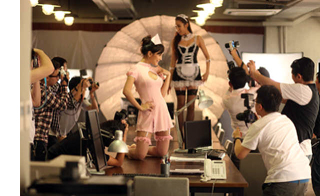 You Are the Apple and Love Fiction center on young men who grow up painfully, bruising others in the process, but Vulgaria keeps us firmly planted in adolescence. Pang Ho-cheung, who has done interesting work in You Shoot, I Shoot (a hitman hires a filmmaker to document his killings) and other projects, gives us what is being packaged as Hong Kong’s dirtiest comedy ever. Reliable sources report that no film has ever before contained such filthy Cantonese. It’s not quite as raunchy as it’s billed, though, and it has a predictably soft center.
You Are the Apple and Love Fiction center on young men who grow up painfully, bruising others in the process, but Vulgaria keeps us firmly planted in adolescence. Pang Ho-cheung, who has done interesting work in You Shoot, I Shoot (a hitman hires a filmmaker to document his killings) and other projects, gives us what is being packaged as Hong Kong’s dirtiest comedy ever. Reliable sources report that no film has ever before contained such filthy Cantonese. It’s not quite as raunchy as it’s billed, though, and it has a predictably soft center.
Chapman To plays a bottom-feeding movie producer who is drafted by a triad investor to make a sequel to the classic Confessions of a Concubine. The investor also insists on casting. He demands a part for the mule with which he seems to have an intensely physical relationship, and more centrally a role for Yum Yum Shaw, a decrepit beauty whom he remembers from the old days. Producer To agrees to all this while trying to keep the love of the daughter he shares with his divorced wife, and to continue a romance with a starlet with quality fellatio stylings. (Her secret weapon is Pop Rocks.) After an engaging setup, the plot gets thrown out of joint in typical Hong Kong fashion. To is knocked into a coma and recovers only to find the film finished and the patron displeased, not least because the director has redone the script with references to Al-Quaeda.
Not bad for a film shot in twelve days and made up as they went along. Still, I think that Pang made a capital mistake in not letting us see any of this bungled project. In particular, he set up the expectation that Yum Yum’s now sagging and plasticine face would be pasted on the starlet’s voluptuous body, and even cheap and clumsy CGI would have added to the fun. In any event, Vulgaria gets off some good-natured satire on the film industry in its financing crisis, and it provides many naughty laughs, not least in the sound effects that continue under the final credits.
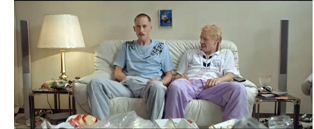 Vulgarity was also the watchword in the Dutch comedy New Kids Turbo (2010). I was unaware of the TV comedy team New Kids, but their brand of politically incorrect slapstick is a little edgier than what we’d find in Hollywood. The aforementioned family-flattening gag and a passage in which policemen are amusingly shot probably wouldn’t make it past the producer notes in America.
Vulgarity was also the watchword in the Dutch comedy New Kids Turbo (2010). I was unaware of the TV comedy team New Kids, but their brand of politically incorrect slapstick is a little edgier than what we’d find in Hollywood. The aforementioned family-flattening gag and a passage in which policemen are amusingly shot probably wouldn’t make it past the producer notes in America.
Funny in small doses, this Five Stooges comedy of stupidity and aggression seemed to me to grow thin as it tried for more scale: the posse of dumb spongers refusing to pay for anything purportedly sets a model for the rest of Holland and calls forth repression from the authorities. I did learn that the planimetric framing on display in Napoleon Dynamite and Wes Anderson movies has become one default for harebrained humor in other countries. Or is it just an easier way to shoot groups of people?
Wuxia, fancy, plain, and very fancy
Painted Skin: The Resurrection.
Action cinema is a mainstay of FanTasia, and I caught several instances. Space Battleship Yamato is a live-action remake of the final installment in the anime series. As befits its origins, this version is rather classically directed, with prolonged medium shots and depth staging, as well as a soft texture that came through nicely on the 35mm print. It’s pure space-opera stuff, with a patriarchal captain passing authority to the young hothead and the emergence of romance between the hothead and the loyal young woman cadet. She turns out to be the secret source of energy that will turn the parched Earth into a green land again, but not without sacrifice in the long-established Japanese tradition.
To a large extent, the popular Chinese films of today are recycling tales and styles established by Hong Kong film in the 1980s and 1990s. Ching Siu-tung signed some of the best fantasy action films of those years (e.g., Duel to the Death, A Chinese Ghost Story, The East Is Red). Borrowing heavily from Tsui Hark’s 1993 Green Snake, The Sorceror and the White Snake offers your basic tale of the yearning and vengefulness of a woman-turned-demon. The main plot centers on White Snake, who falls in love with a herbalist and tries to pass for human. But Jet Li, looking like he’s suffered a few too many punches over the last three decades, is an abbot searching for demons to capture and imprison in his monastery. In a symmetrical subplot, the abbot’s young assistant turns into a bat demon but gains a friendship with White Snake’s counterpart Green Snake. When Li shows the herbalist his wife’s true nature, he breaks the marriage and unleashes White Snake’s fury.
Cue the video-game special effects for whirlwinds, floods, exploding temples, and soaring leaps. The airy effortlessness of all this comic-book spectacle made me yearn for the days of wirework; at least then gravitational heft limited the actors’ aerobatics. And cue a romantically inflated ending that pulls the couple apart to the tune of a duet sung by the pop-singer players on screen. A graceful, sinuous introduction of the two heroines (see the frame up top) and some interesting cutting in dialogue scenes (e.g., various scales of two-shots breaking up lines) couldn’t wipe away my sense that this has all been better done before–not least by Ching himself.
I did get my wire-work wish in Reign of Assassins, a pan-Asian project drawing on HK, PRC, Taiwanese, and Korean talent. Here Michelle Yeoh is given more to do than Jet Li was as the Sorceror. This film is engagingly old-fashioned, avoiding CGI for the most part and scaling the action to the everyday and the earth, not the sky. Michelle foreswears her past as an outlaw, undergoes the equivalent of plastic surgery, and tries to start fresh with a humble husband. But her old team’s search for the monk Bodhi’s corpse brings her back into action. In a plot twist reminiscent of the Shaw Bros. era, the husband reveals himself to be not all that she thought.
The fights are ingeniously staged by veteran Stephen Tung, but many are presented in that abrupt, disorienting framing and cutting that seems de rigueur these days. Taiwanese director Su Chao-pin is credited with story and direction, though a title on this print claimed the “co-director” to be John Woo, who was also a producer. On the whole, I respected Reign of Assassins more than I liked it. But nearly everybody thinks better of it than I do, as witness Justin Chang’s Variety review, the Hong Kong Movie Database reviews, and the customary detailed appraisal provided by Derek Elley in Film Business Asia. So maybe I should see it again.
The most elegant wuxia exercise I saw was Painted Skin: The Resurrection, fresh from its premiere at the Shanghai Film Festival (and in superb 35mm). King Hu made a version of the original tale in 1993, but this project has little relation to that, and only a tenuous one to the 2008 Hong Kong Painted Skin. That was a confused enterprise whose only redeeming feature seemed to me to be Donnie Yen. This installment more or less abandons the plot material of the 2008 film, while keeping many of the performers. It’s a solid, confident achievement, blending pathos, romance, and fantasy with an unhurried restraint largely missing from The Sorcerer and the White Snake.
Like that film, there’s a double plot centering on two female demons. A fox demon offers to swap her body for that of a disfigured princess, while in a minor-key subplot a bird demon develops affection for a demon hunter. Director Wuershan, fresh off his success with The Butcher, the Chef, and the Swordsman (2010), treats both the magic scenes and the erotic encounters with a grave warmth that elevates them above the genre standard. If you can have dignified eye candy, this movie offers it: sumptuous costumes and sets, striking but not go-for-broke special effects, combats that discreetly exploit the stammering ramping effects of 300. But the oscillating relations of the two central woman, tracing rivalry, complicity, envy, and loss, remain firmly at the action’s center.
Hong Kong filmmakers developed these mythic formulas in the 1980s and 1990s, when such “feudal” and “superstitious” subjects were forbidden on mainland screens. The slick assurance with which new mainland filmmakers have mastered this material suggests that in the new liberalization of the mainland market, they now own this genre. Painted Skin: The Resurrection has quickly become the biggest box-office hit in PRC history.
Crossovers
Carré blanc.
Everyone has noticed that genre pictures are getting artier, or art films are getting more genre-fied. Crossover efforts can yield strong results, as shown by movies as different as Let the Right One In and Drive. The title Eddie the Sleepwalking Cannibal would seem to signal B-movie giggles and gasps, but it turns out to be a tight, restrained study of the sadism driving artistic creativity….and a certain number of giggles and gasps.
A painter in a career slump, and following an unspecified “accident,” accepts a teaching post in a Canadian art school in hopes of calming down. He takes in a mentally deficient young man who grabs and eats animals while he’s sleepwalking, or sometimes sleeprunning. 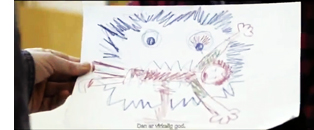 When you learn that the painter’s neighbor is an obnoxious oaf with a perpetually barking dog, you begin to think that Eddie will be the painter’s means of securing peace and quiet. Actually, Eddie’s depredations unlock the painter’s creativity, inspiring a new burst of excellent work. Thereafter, he’ll need to keep Eddie on the prowl.
When you learn that the painter’s neighbor is an obnoxious oaf with a perpetually barking dog, you begin to think that Eddie will be the painter’s means of securing peace and quiet. Actually, Eddie’s depredations unlock the painter’s creativity, inspiring a new burst of excellent work. Thereafter, he’ll need to keep Eddie on the prowl.
The film balances gore, comedy, pathos, and satire of the art world. When the painter realizes that the young woman he’s slept with is a good sculptor, his efforts to deflate her using CritiqueSpeak reveal that his apparent humility covers an angry competitiveness. Eddie isn’t exactly Henry James on the creative process, I admit, but it’s not A Bucket of Blood either. The movie looks very trim and polished, with excellent sound work; I regret only the tendency to treat every dialogue scene in a fusillade of tight close-ups, which leads to a fairly unvarying pace. There’s a reason Coen brothers cut fairly slowly and stay far back; this sort of queasy deadpan tension benefits from steadiness and silence.
The screening of Carré blanc was preceded by La Jetée, as a tribute to Chris Marker. It was completely appropriate. For one thing, La Jetée hinges on one of the paradoxes of time travel: Can a man witness his own death? This sort of mind-bending was amusingly dealt with in Aleksey Fedorchenko’s “Chrono Eye,” one of three shorts in the portmanteau movie The Fourth Dimension. A scientist clamps a camera to his head and tries to tune himself to the future or the past, with the results transmitted to a beat-up TV receiver. The film makes clever use of the fallen-camera convention, and it ends with a rejection of past and future in the name of a vivacious present.
La Jetée was prophetic in another way. Before Marker’s film, most science fiction movies, from Metropolis and Things to Come to The Time Machine, used fanciful sets to conjure up the future. But Marker realized that one could film today’s cities in ways that suggested that the future was already here. This opened up a rich vein of exploration in Alphaville, THX 1138, Le Dernière combat, and their successors. And if you haven’t noticed: That future-tense present is always bleak, totalitarian, and something to escape from.
No wonder, then, that Carré blanc becomes an arty dystopian fable about a boy and girl brought up in a totally administered society. Philippe’s mother commits suicide so that he can be taken into an orphanage. There he will be turned into “a normal monster,” thus assuring his survival. Grown-up, he’s a high-level bureaucrat administering childish tests that his victims never seem to pass. But his marriage to Marie is withering. They can’t have a child, and she spends her days wandering the city. Eventually things come to a crisis and the couple must decide whether to stay or try to flee.
The plot is pretty formulaic and some of the absurd touches seem forced (the national sport is croquet). But the pictorial handling engages your interest from the start. Call it “1984 meets Red Desert,” except that there’s not much red here: bronze, black, and amber dominate. Simple techniques, like lighting that hollows out people’s faces to the point of blankness, become very evocative.
As in Alphaville, actual locations are made sinister by the dry public-address announcements saturating the soundtrack. The vast net stretched outside the couple’s apartment complex recalls the harrowing images of suicide-prevention nets at Chinese factory complexes. What a pleasure to see a movie designed shot by shot; the fixed camera yields one startling composition after another. Familiar as the story and themes are, the style grows organically from them. Carré blanc was the most impressive piece of atmospheric cinema I saw in my FanTasia visit.
So why was I here?
To see the movies. To catch up with old friends like Peter Rist and King Wei-chun and to make new ones. To present a talk on the Hong Kong action tradition. And to get an award for “Career Excellence.” Say hello to my lee’l (actually not so lee’l) frien’.
I’m very grateful to the coordinators of FanTasia for inviting me and honoring me with this magnificent award. It was an unforgettable week.
In addition to all this, FanTasia held an avant-premiere of the exhilarating ParaNorman (below). After I’ve seen it again, preferably with Kristin, I hope to write about it here.
Jason Seaver has blogged loyally about the festival on a daily basis. Liz Ferguson has a series of articles in the Montreal Gazette. A short interview with me appears on the FanTasia YouTube channel. Juan Llamas Rodriguez offers a two-part commentary on it starting here.
P. S. 11 August 2012: Daniel Kasman of MUBI has provided a link to Chris Marker’s little-known site Gorgomancy, which includes viewing copies of some of his little-known films.
P. P. S. 13 August 2012: Marc Lamothe–film director, co-director of FanTasia, and creator of DJ XL5’s Italian Dance Party–writes to explain the origin of the meowing.
Besides my national genre cinema tribute, every year since 2004 I’ve edited a short film program for FanTasia. It’s constructed the same way the Italian zappin’ was. I put static between films and include old vintage videos, ads and obscure film trailer in between films to simulate an evening of zappin’. This brings an energy and rhythm to short film presentations.
In 2008, I had a screening entitled DJ XL5’s DJ XL5’s Hellzapoppin Zappin’ Party. The program was constructed in 2 parts, with each part on a 60-min beta tape. Both part one and two contained episodes of Simon Tofield’s Simon’s Cat. To switch from beta one to beta two meant some 30 seconds of blackness and silence in the room. As Simon’s Cat made a strong and loving impression on the crowd, during the short intermission for chaning from tape 1 to 2 some people started meowing to break the silence. That made the others laugh and signaled their affection for the character.
This inside joke spilled over into more serious film presentations and has became a staple of our audience. Here’s the film responsible for the phenomena: http://www.youtube.com/watch?v=w0ffwDYo00Q.
Thanks to Marc for the information, and for a fine festival. Thanks also for his kind words about our work; he read the second edition of Film Art back in the early 1980s!
“Indie blockbuster franchise” is not an oxymoron
Kristin here:
The Cannes Film Festival continues even as I type. Much of the wheeling and dealing at the market that accompanies the festival is being driven by two franchises that few people outside the film industry think of as independent films: the Twilight and Hunger Games series. Indie blockbuster franchises aren’t common. In fact, there had previously been only one, but its parallels to these contemporary franchises reflect a recent major shift in international independent distribution.
True or false, The Lord of the Rings is an indie film
In May of 2001, I, as a Tolkien fan since high school, was resolutely ignoring the production of a film adaptation of The Lord of the Rings, going on in New Zealand. The first part of the trilogy was to be released in December, and there was widespread skepticism in the press, both popular and trade, and among fans and industry insiders concerning the possibility of the film’s being a success. Another fantasy adaptation, Harry Potter and the Sorcerer’s Stone, looked likely to be the hit of the Christmas season, eclipsing New Line Cinema’s expensive gamble.
Then came New Line’s Cannes event of 2001. Over a three-day weekend, the studio presented an elaborate program to reveal the film. On Friday night there was a screening of a 26-minute preview of footage from all three films, with an extended portion of the Mines of Moria scene in nearly completed form as its centerpiece. Even cast and crew members present, as well as top New Line officials, had not yet seen any of the film’s finished footage until that screening, and they were overwhelmed. Jaded reporters cheered and asked to have the preview re-run. Extra screenings had to be arranged. A series of press interviews were held, and a lavish party complete with sets and props from the film was held in a chateau. Suddenly the popular press was full of infotainment pieces predicting that the trilogy would be a blockbuster hit. Fan webmasters invited to the event posted enthusiastic, even ecstatic reports.
Variety’s report of the preview screening is the first article about the film that I remember reading. It began:
It’s hard to imagine a more relieved group of distribs gathered into one place than the collection who’d just finished watching a 26-minute film from New Zealand that cost $270 million.
The enthusiastic response from distribs, exhibs and worldwide press to the screening of footage from New Line’s “Lord of the Rings” at Cannes Olympia theater means that foreign companies that bet the farm on the three-year franchise now have cause for confidence they’ll recoup their investment–with coin to spare. […]
In marketing meetings after the screenings, NL execs told distribs that the target is for all of them to outdo the previous top grosser in their territory. In some countries, that’s going to mean spending as much again on P&A [prints and advertising] as they did to buy the films in the first place, but at least now that seems more like an opportunity than a terrifying risk.
Rolf Mittweg, at the time head of New Line’s international marketing and distribution, noted: “My Japanese distributor said he had a knot in his stomach for the whole year, and now it has dissolved.” [Adam Dawtrey, “Will ‘Lord’ ring New Line’s bell?” 21-27 May 2001, pp. 1, 66.]
This considerably intrigued me, and it was probably the first step in the long path that ended with me writing The Frodo Franchise: The Lord of the Rings and Modern Hollywood.
What Variety was referring to, it turned out, was the twenty-six independent distributors from various territories around the world who were forced by New Line, if they wanted LOTR, to pay large sums up front for the film, sight unseen. That in itself wasn’t odd, since independent films were commonly financed in part by pre-sales to international distributors, often on the basis of a script or a star attached to the project. The difference here was that the chosen twenty-six had to pay a lot (as much as $8 million for the larger European territories) for all three feature-length parts of the film. If the first one flopped, the second and third would be almost worthless. Small wonder they were nervous going into the Cannes event.
As everyone knows, LOTR went on to enormous success, with the third installment becoming only the second film to cross a billion dollars in worldwide grosses (the first having been Titanic in 1997).
Many people would be surprised to learn, however, that LOTR was not the product of one of the major Hollywood studios. It came from an independent company, New Line. True, New Line was at that point owned by Time Warner, but it operated as an independent film producer-distributor. That is, it didn’t receive financing for its films from its parent company but through pre-sales–pretty much the definition of an indie establishment. It was also a studio that thrived in part because it stressed franchises, notably the Nightmare on Elm Street, Teenage Mutant Ninja Turtles, Rush Hour, and Austin Powers films. Successful though these were, LOTR was a step up for New Line, both in terms of prestige and budget. It was perhaps the first indie blockbuster franchise.
It was such a blockbuster, in fact, that LOTR helped pull the international independent and foreign-language film market out of a major slump that had begun in mid-2000 in the wake of over-production in the late 1990s. The crises in the Brazilian and Argentinian economies in 1999, the bursting of the dotcom bubble in mid-2000, and the 9/11 attacks in 2001 worsened the decline. I won’t go into detail here. (You can read a more thorough account in Chapter 9 of my book.) Suffice to say that the crisis happened to be at its worst when The Fellowship of the Ring came out in mid-December, 2001. During the first half of 2002, there were slight signs of a recovery, but the accumulating income from the film and also from the summer release of the DVD strengthened it considerably. By the time of the American Film Market in early 2003, The Hollywood Reporter ran the caricature above and declared, “With his quest to save Middle-earth from the Dark Lord, the intrepid hobbit might have helped rescue the annual event from the clutches of a global recession.”
As a result, the lucky 26 distributors were able to buy more at the AFM and other important indie sales venues. Reporting from Cannes, Variety declared, “The global bonanzas of ‘Lord of the Rings’ is playing its part in driving big-budget pre-sales.” Screen International said New Line was “buoying the indie market with The Lord of the Rings.” Sales and pre-sales of indie films were up. Small companies could afford to buy more desirable films than in the past. For example, SF Film in Denmark (a branch of Sweden’s AB Svenska Filmindustri) was able to acquire Million-Dollar Baby, a film that previously would have been beyond its means. A few of these companies also used their LOTR money to produce local films or to open art-house cinemas.
The problem was, the film had only three parts. New Line’s next attempt at a blockbuster franchise would knock the biggest supplier of indie films to foreign distributors entirely out of the market.
The New Line void
On December 7, 2007, The Golden Compass was released, the first in an intended trilogy based on the “His Dark Materials,” a trio of prize-winning books by another English author, Philip Pullman. With a reported production budget of $180 million, the film grossed about $70 domestically, though it managed $372 million worldwide.
On March 28, 2008, four years and four weeks after The Return of the King won eleven Oscars, Time Warner announced that New Line would be absorbed into Warner Bros. Entertainment as a genre unit. Its domestic distribution and international sales activities would be dissolved. The top executives of the international sales wing, Rolf Mittweg and Camela Galano, who had helped put together the enormously complex group of foreign distributors who largely financed LOTR, would soon be out of jobs. The fact that the change came less than two months before the Cannes Film Festival led trade papers to assess New Line’s importance as a supplier to the international independent market and to speculate on what companies might step into the void left by its departure.
(For my own analysis of what the loss of New Line product would mean for the indie market, see “Filling the New Line gap,” from November 6, 2008.)
Shortly after the March announcement, Screen International editor Mike Goodridge looked back at the impact of Peter Jackson’s trilogy on the distributors who released it abroad:
The success of the three films for the international partners cannot be overestimated. Nor can the fact they, more than anybody involved, took a huge risk on the trilogy. The risk paid off. The Greens at Entertainment [UK distributor], the Hadidas at Metropolitan [French distributor] and others genuinely shared in the profits of one of the box-office phenomenons of of the last 20 years. It was the international buyers’ dream. Instead of losing money on studio cast-offs, they had a hefty piece of a trilogy which grossed nearly $2bn outside North America. [“The End of the Line,” 7 March 2008, p. 6.]
Goodridge points out that although The Golden Compass, New Line’s intended first entry in the “His Dark Materials” trilogy, had not done well in North America, its box-office abroad was likely to hit in the region of $300 and speculated that if it did, “Warner Bros. will be hard-pressed to deny production to a sequel.” [p. 8]
This optimistic view generously assumes that Warners would want to reward New Line’s old customers abroad by making the two remaining films in the trilogy despite a possible repeat of the first installment’s lackluster domestic gross. Instead, Jeff Bewkes had no interest in keeping up alliances with those loyal distributors, since by investing in the production of films up front, those distributors got to keep most of the box-office takings in their respective countries. As Bewkes said, “With the growing importance of international revenues, it makes sense for New Line to retain its international film rights and to exploit them through Warner Bros.’ global distribution infrastructure.” (For more on the international implications of the absorption of New Line, see this piece on my Frodo Franchise blog.)
Goodridge quotes San Fu Maltha, head of Dutch distributor A-Film (which had the LOTR trilogy for the Netherlands): “New Line was one of the supplier of major films. For [the distributors,] it was, if not a lifeline, an important source.” New Line films from 2007 that had done well abroad included Hairspray, Rush Hour 3, and The Golden Compass. Earlier hits had been entries in the franchises that had traditionally driven New Line’s success: the Austin Powers series, the Nightmare on Elm Street series, and so on. Goodridge concluded that Summit and Overture would be major sources of quality films for the foreign market.
In early May, 2008, with Cannes looming, Variety ran a story about the opportunities opened by New Line’s departure from the market. The subtitle suggests how big the change was perceived to be: “Opportunities Rock: Fresh contenders eager to join international indie scene’s new world order.” The story speculated on the various independent sales groups that will be at Cannes and which ones might be strong enough to replace New Line: QED, with W, District 9, and A Perfect Getaway; Essential Entertainment, with My One and Only; The Film Department’s Law Abiding Citizen and The Rebound.
Swart also noted changes in two major suppliers to the indie market. Summit was growing, having opened its own domestic distribution wing. It “is chasing studio ambitions, which seems to have taken the main emphasis off foreign sales.” Mandate (notable for Juno and the Harold and Kumar sequels) had been acquired by Lionsgate in September, 2007.
Cannes also provided the occasion for a second in-depth analysis of the New Line void by Screen International. Author John Hazelton suggested that New Line’s regular supply of six to eight films to its regular distributors overseas benefited international indies as a whole:
Many sales executives, in fact, go further and suggest that by boosting the fortunes of the distributor partners with which it had ongoing output or package deals—companies including the UK’s Entertainment, France’s Metropolitan, Australia’s Village Roadshow and Spain’s Tri Pictures—New Line effectively elevated the independent international industry as a whole. Other sellers benefited, for example, when the New Line distributors reinvested profits from The Lord Of The Rings and Rush Hour movies—or from last Christmas’ The Golden Compass—in the acquisition of non-New Line films.
Hazelton quotes Steve Bickel, president of The Film Department’s international wing: “New Line provided a great service to all of us because they helped make strong companies that we’re now able to sell to.” The author also presciently singles out Summit and the newly merged Lionsgate and Mandate as “leading the field of remaining big picture suppliers,” noting that both companies had recently expanded into domestic distribution and were signing output deals in some foreign countries.
The article refers to The Weinstein Company and The Film Department as promising new players. Relativity, having produced Atonement, Evan Almighty, Baby Mama and Pineapple Express, was moving for the first time into international sales at Cannes. Other companies are mentioned as possibilities. Hazelton concludes:
On its own, Relativity probably will not fill the gap created by the disappearance of New Line from the business that A Nightmare On Elm Street, The Mask and The Lord of the Rings helped build. And neither will any of the other sales companies or producers now eyeing the fresh demand for upscale product from international buyers. But between them, the new entrants, growing boutiques and established players will be trying fill the New Line-shaped void appearing on the international sales landscape.
Reporting that autumn on the American Film Market, Screen International noted that The Weinstein Company had sold five films to Entertainment, formerly supplied by New Line. These included The Reader, Zack And Miri Make a Porno, and Piranha 3-D. Relativity had closed multi-year output deals with several overseas distributors, including former New Line customers Village Roadshow (Australia, New Zealand, and Greece) and Alliance Films (Canada). Neither company, however, would be the one to release the second indie blockbuster franchise.
From New Line to New Moon
In 2008, the world was in a global recession brought on by the financial crisis of 2007. But even as the trade press was speculating on which company or companies would replace New Line, help was on the way. Summit’s release of Twilight came in November of the same year, and although it did not make as much as the three following films in the franchise so far released, it grossed nearly $393 million internationally, $200 million of that outside North America. A healthy take for a film reportedly budgeted at $37 million.
The modest title did not indicate that Twilight was the launch of a franchise, though obviously Summit was hoping that it would be. The subsequent entries were more forthright and more lucrative: The Twilight Saga: New Moon (November, 2009, nearly $710 million worldwide), The Twilight Saga: Eclipse (June, 2010, about $700 million), and The Twilight Saga: Breaking Dawn Part 1 (November, 2011, just over $705 million), with the final installment due out in November of this year.
On the occasion of the second film’s release, Mike Goodridge of Screen International noted that the franchise’s success echoed that of a certain earlier series:
Distributed in major territories by companies which had signed to output deals with Summit Entertainment for its in-house productions, the first film, Twilight, was a sensation buyers were hardly anticipating when they made the initial deals. [….] Seeing E1 Films take nearly $20m in the UK, SND in France scoring $17m, Eagle in Italy $14.3m and Aurum in Spain $13.7m last weekend brought back the heady days of The Lord of the Rings openings.
Goodridge also pointed out:
What The Lord of the Rings proved and the Twilight Saga reaffirms is that this kind of independent success is good for everybody. The Twilight distributors will have more money to invest in financing and acquisitions, benefiting other independent productions, while sales companies struggling to get films off the ground in a turgid distribution world will hopefully encounter a renewed buoyancy in the international markets.
He concluded, “For independents, the loss of New Line wasn’t as damaging as first imagined.” [“New Moon’s new line of success,” ScreenDaily.com, 26 November 2009.] It should be pointed out, though, that the gap between the third LOTR film and the first Twilight one was six years.
The Lionsgate share
On January 13, 2012, Lionsgate finalized its deal to buy Summit, thus acquiring the Twilight series. On March 23, Lionsgate released The Hunger Games, with an opening weekend of over $152 million domestically and a worldwide gross of $637 million after 9 weeks in release. Within less than three months, the company came to control the two largest indie franchises since LOTR. In late March, a financial analysis of Lionsgate by The Hollywood Reporter remarked, “The rest of the Hunger Games movies will now bring in significantly higher returns.” [Alex Ben Block, “How ‘Hunger Games’ Box Office Haul Impacts Lionsgate’s Bottom Line,” The Hollywood Reporter, 3 March 2012.] The reference was to the sales of foreign distribution rights, not higher box-office grosses.
Given how recent these events are, it happens that only two international distributors control both the Twilight series and The Hunger Games for their respective territories: Paris Filmes, of Brazil, and Nordisk Films, Denmark. Peter Philipsen, general manager for independent films at the latter told Variety that such series are rare: “There are not a lot of franchises in this business that really work, let along in the independent market,” Philipsen notes. “The last one before ‘Twilight’ was ‘Lord of the Rings,’ which was huge and gave a really big boost to the business as a whole.” [Diana Lodderhose and Adam Dawtrey, “International buyers eye bigger pics,” Variety.com, 5 May 2012.]
If Twilight helped ease the pain of the global recession for many indie distributors worldwide, by Cannes, 2012, the accumulating impact of its franchise and the addition of The Hunger Games led to greater prosperity. Those films and other successful non-franchise movies (some presumably bought with money from the Twilight franchise) led foreign distributors at this year’s Cannes festival to look for bigger films. Diana Lodderhose and Adam Dawtrey reported in Variety:
Sales agents brought a number of well-received big-budget projects to market last year, notably “Cloud Atlas,” “Pompeii” and “Enders Game.” But this year, with the indie sector stronger theatrically than it has been in years, and with international distributors flush with success from pics like the “Twilight” franchise and “The Hunger Games,” as well as “The Iron Lady,” “The Woman in Black,” “The Artist” and “Midnight in Paris” all having performed well territorially, there’s a feeling among buyers that bigger is better.”
A large number of new indie companies have emerged, many of them started by executives formerly at Summit, Lionsgate, and New Line. Among those represented at Cannes for the first time this year is Speranz13 Media, headed by Camela Galano, mentioned above as having helped arrange pre-sales for LOTR at New Line. Variety commented:
Pre-Cannes, a raft of new sales outfits headed by esteemed execs […], coupled with more money in the pockets of indie distribs who had successful runs with such pics as the latest “Twilight” installment, “The Hunger Games” and “The Intouchables,” suggested that this would be a market with greater liquidity.
And it has been.
“Many indie buyers have money now and they know what they want, which is studio-level movies,” said Foresight’s Tama Stuparich de la Barra, whose projects “Lone Survivor” and “Motor City” sold out at the market. [Diana Lodderhose and Dave McNary, “Cannes market totes up solid business,” 21 May, 2012.]
One notable aspect of all this is a return to pre-sales for financing big independent films. A few years ago, pre-sales were declared dead, partly because distributors couldn’t afford to invest in unmade projects. Lionsgate, however, financed about 60% of The Hunger Games through the sales of individual foreign sales rights. Production rebates from North Carolina kept the film’s budget at a relatively modest $80 million, limiting the studio’s risk on the film. These strategies are similar to what New Line tried while making LOTR.
I have yet to see coverage of Cannes that explicitly dubs Lionsgate the successor to New Line, the new indie “mini-major” that will supply a steady stream of films to foreign distributors with which it has output deals. Still, the conclusion seems all but made. At Cannes it began pre-sales for Catching Fire, the sequel to The Hunger Games. On May 23 it announced a long-term renewal of its partnership with the powerful French producer-distributor StudioCanal, including a deal for StudioCanal to distribute Catching Fire in German-speaking regions. Under this partnership Lionsgate has certain distribution rights to StudioCanal’s huge library of film and television titles, the third largest in the world, including titles ranging from Grand Illusion and The Discreet Charm of the Bourgeoisie to Terminator 2 and The Deer Hunter. [Dave McNary, “Lionsgate, Studiocanal extend pact,” Variety.com, 23 May 2012] On May 24, Screen International summed how various sales for various companies at Cannes were going:
Patrick Wachsberger and Helen Lee Kim reported a roaring trade on the Lionsgage slate, especially the Dirty Dancing remake. “It has been a strong market for us and the team has been seamless,” Wachsberger said of the post-merger infrastructure. [Jeremy Kay, “Market buoyed by sellouts,” 24 May 2012, p. 1.]
No doubt at some point Lionsgate will face a financial crisis and lose its central status, but with two big indie franchises in progress, it seems settled for the foreseeable future and beyond.
Ironically, the blockbuster franchise that started it all will resume this year, but not in the indie sector. The two parts of The Hobbit, due to be released in December of this year and 2013 as prequels to LOTR, are being produced by New Line. They are not being financed by pre-sales to indie distributors around the world. Instead Warner Bros. is providing funding, and it will also distribute.
I have linked to stories when I could find them online, but some articles I quoted are either behind paywalls or simply not online. They are taken from issues of the trade papers mentioned in the text.
The illustration at the top of the entry topped an article called “Hey, Big Spenders,” cited above. It appeared in The Hollywood Reporter (February 2003), pp. 1, 4, 8, 12. The piece dealt with the American Film Market, which at that time still happened in the spring. Naturally the caricature of Frodo tossing money around caught my eye. (The distributors flush with LOTR cash are, left to right, Joel Pearlman of Roadshow Films, Australia (?); Trevor Green of Entertainment Film Distributors, UK; and Hiromitsu Kurukawa, Nippon Herald Pictures, Japan.) This was one of the few articles I found in the trade press that dealt with the considerable impact that LOTR had on the international indie and foreign-language film market. I used the caricature as an illustration in Chapter 9 of my book. After all, how do you illustrate the concept of a film helping pull the indie business out of a global slump? That picture was ready-made for such a topic. I contacted the artist, Victor Juhasz, for permission to reprint the image, which he kindly gave. It occurred to me that he would be the ideal person to provide an image for the cover of the book as well. Again, how do you illustrate the general concept of a franchise based on The Lord of the Rings? Have a character surrounded by licensed products based on that character, I figured. Fortunately the University of California Press agreed. Based on photos, an action figure, a polystone collectible bust, and a video-game strategy book that I sent him, Victor produced exactly what I had in mind. A small image of that cover illustration appears up at the right, beside the Hollywood Reporter caricature.












